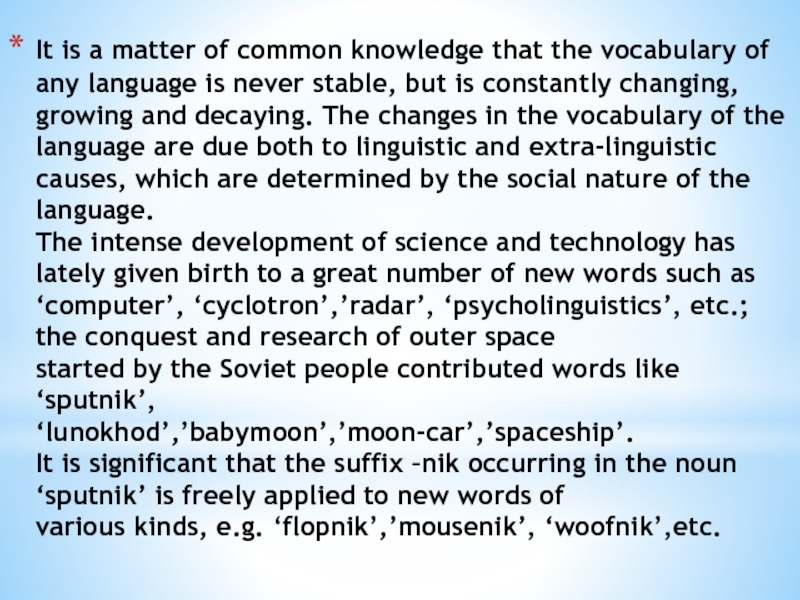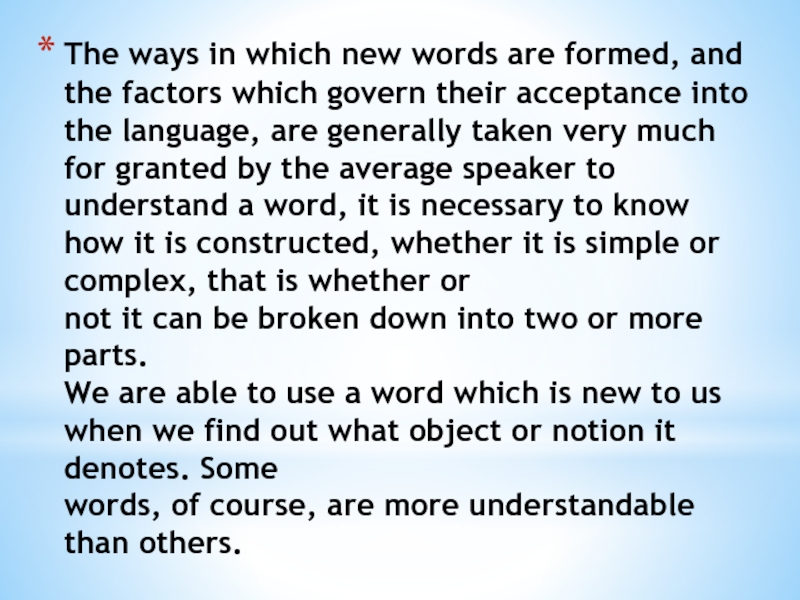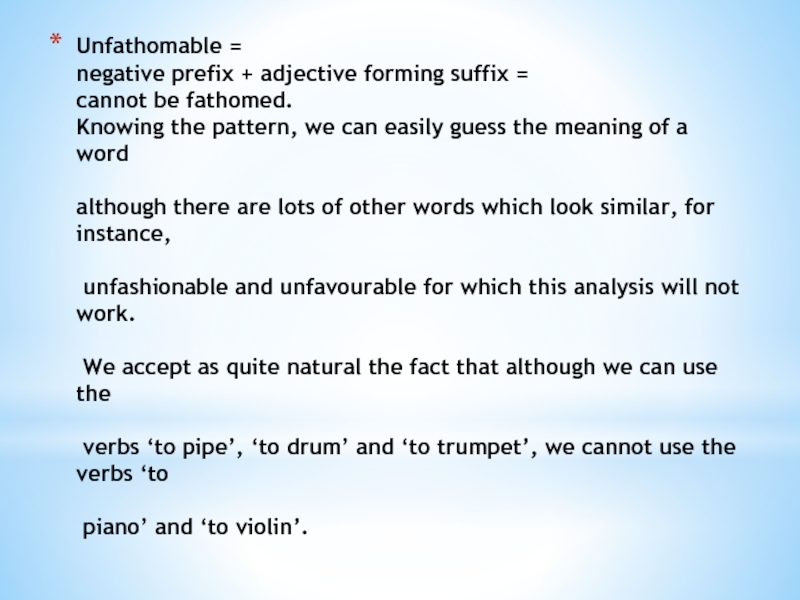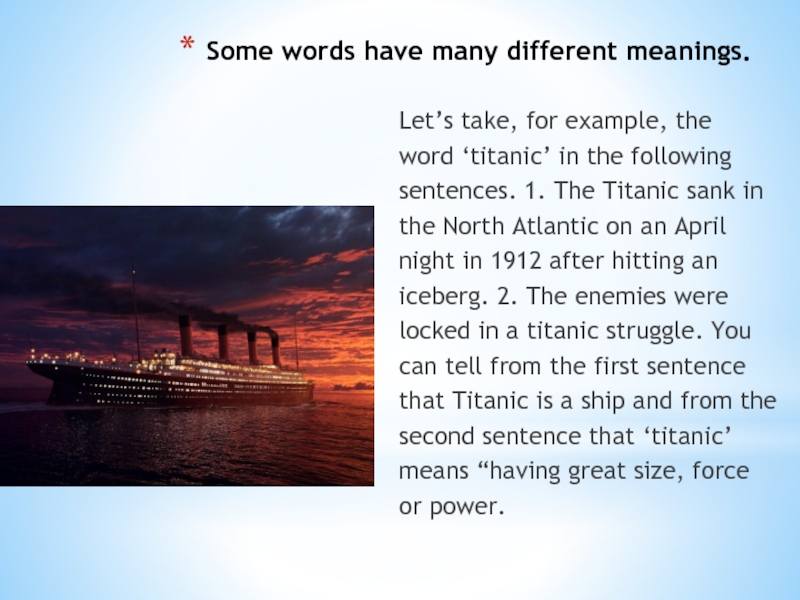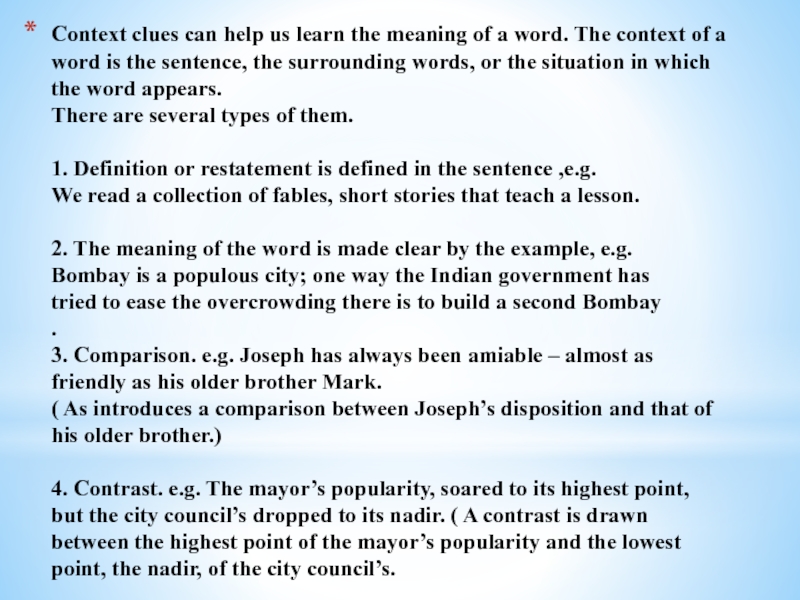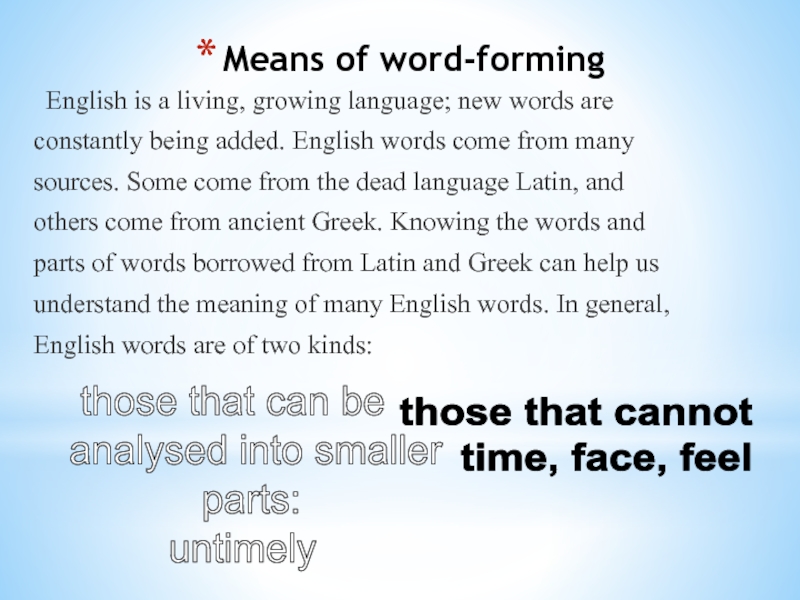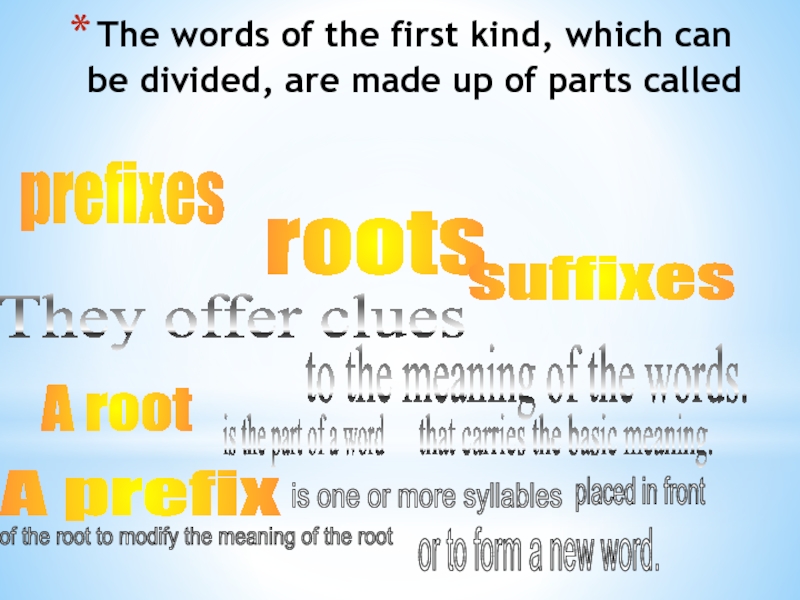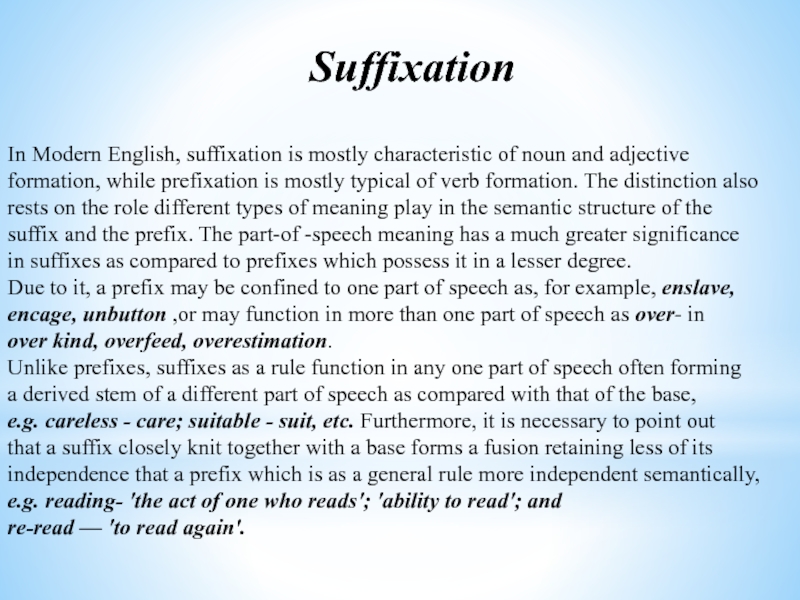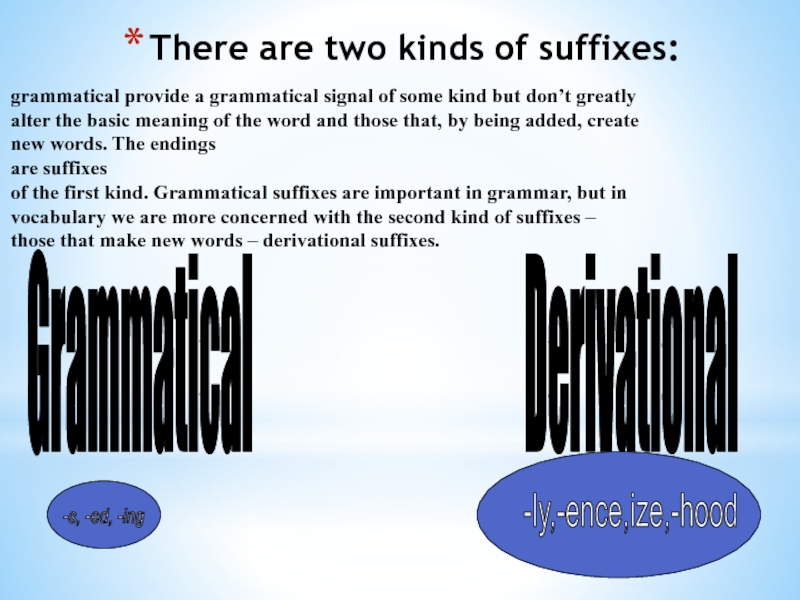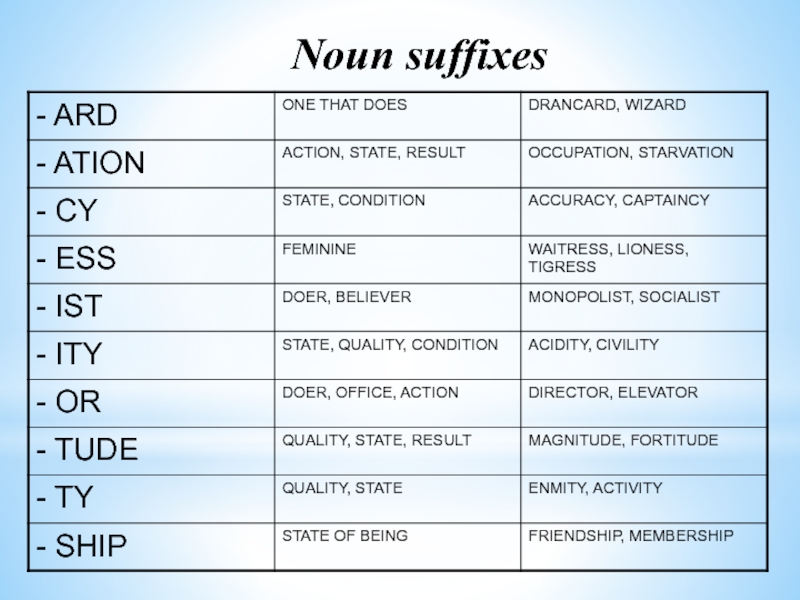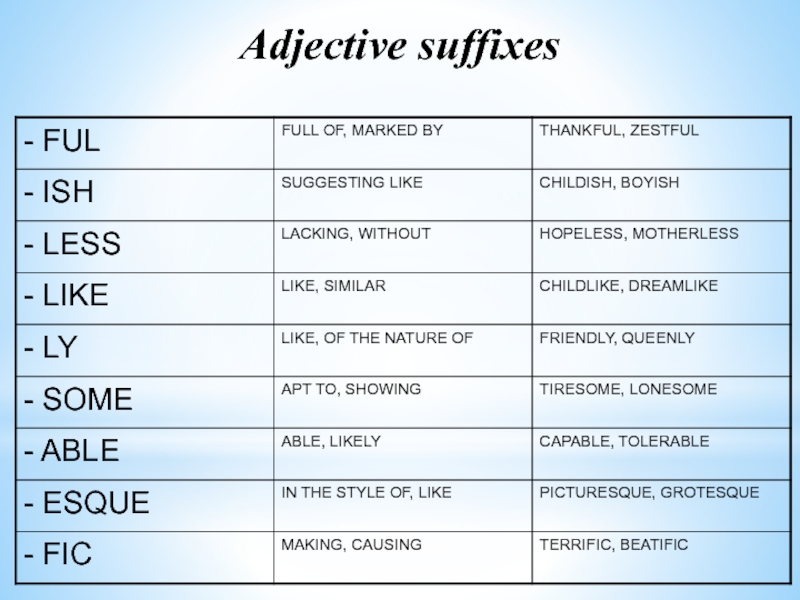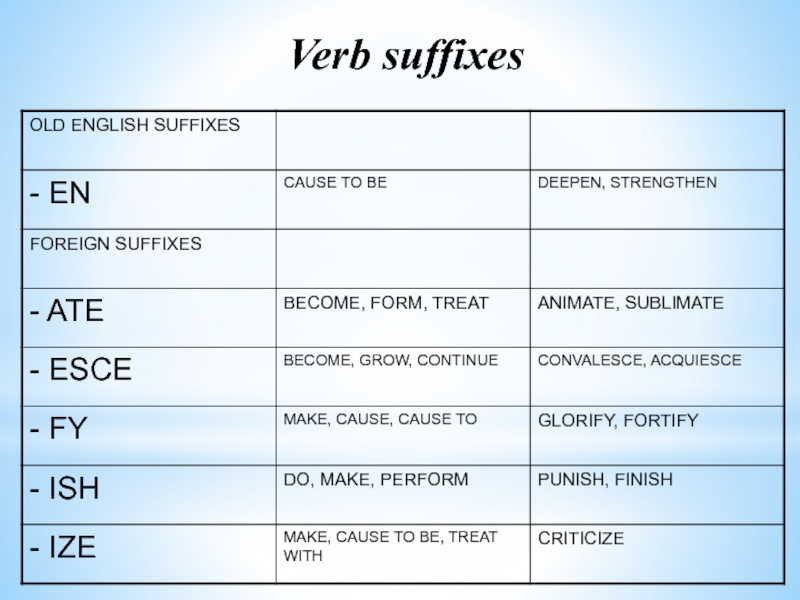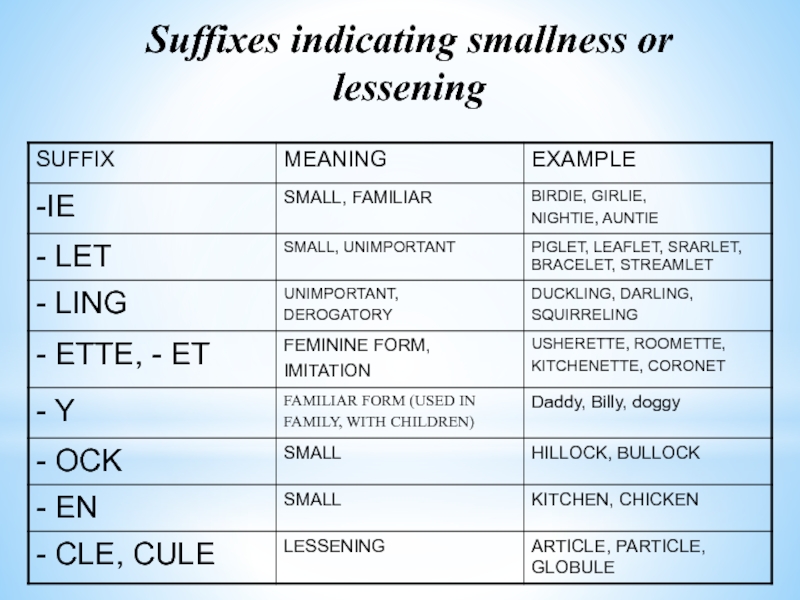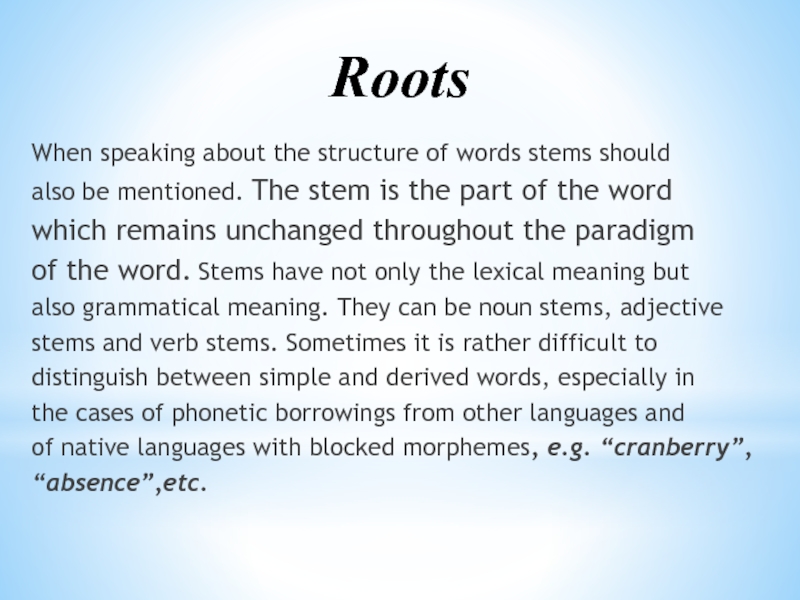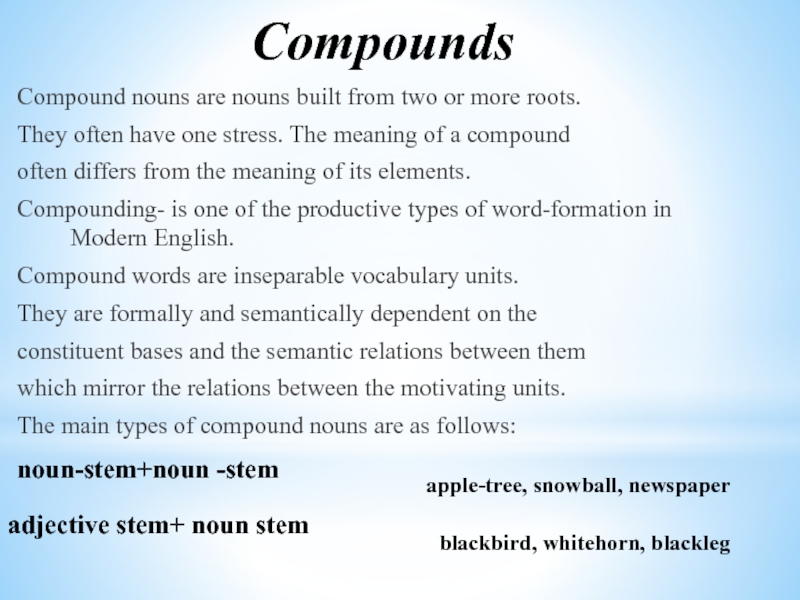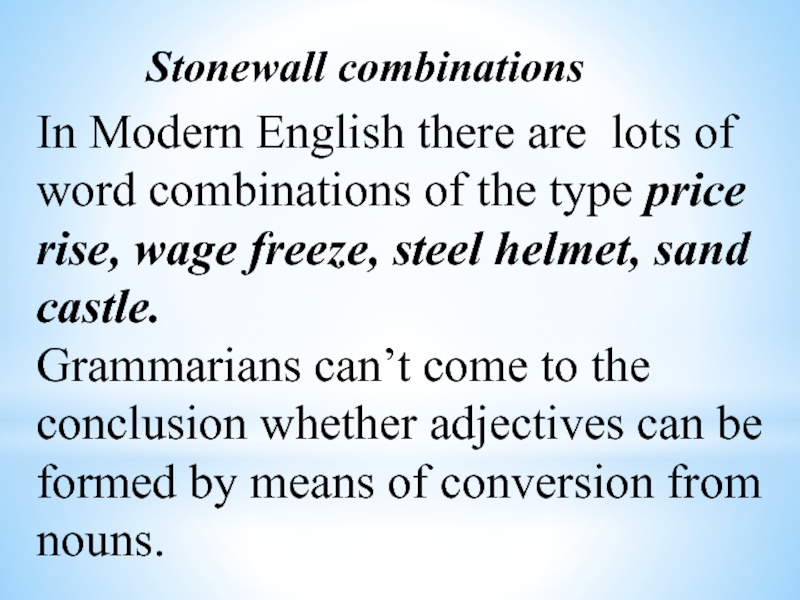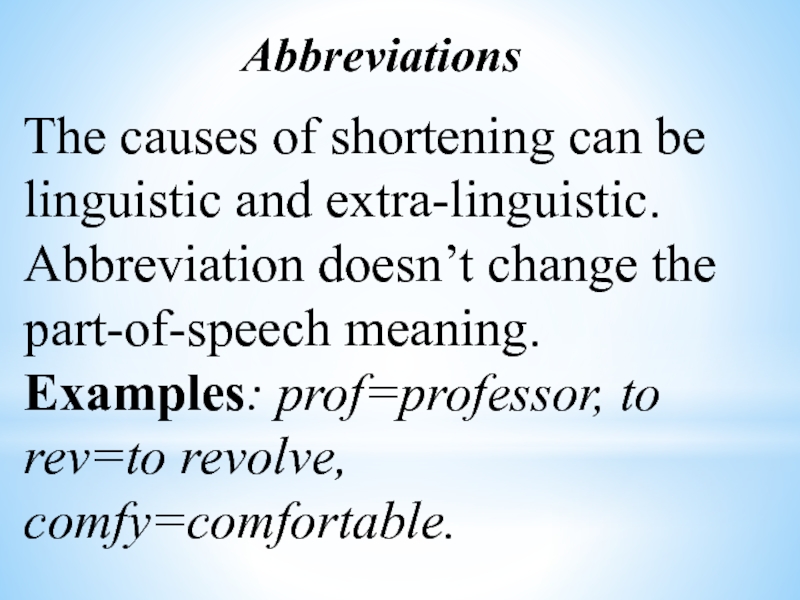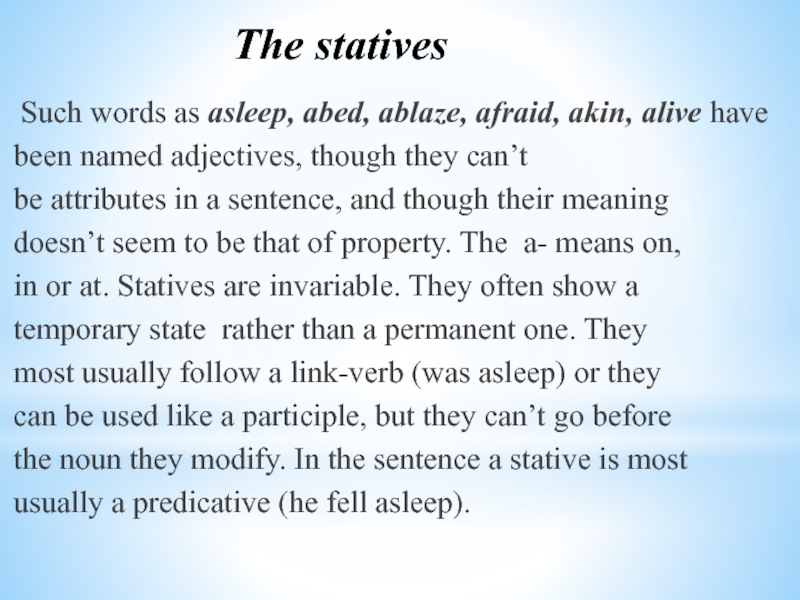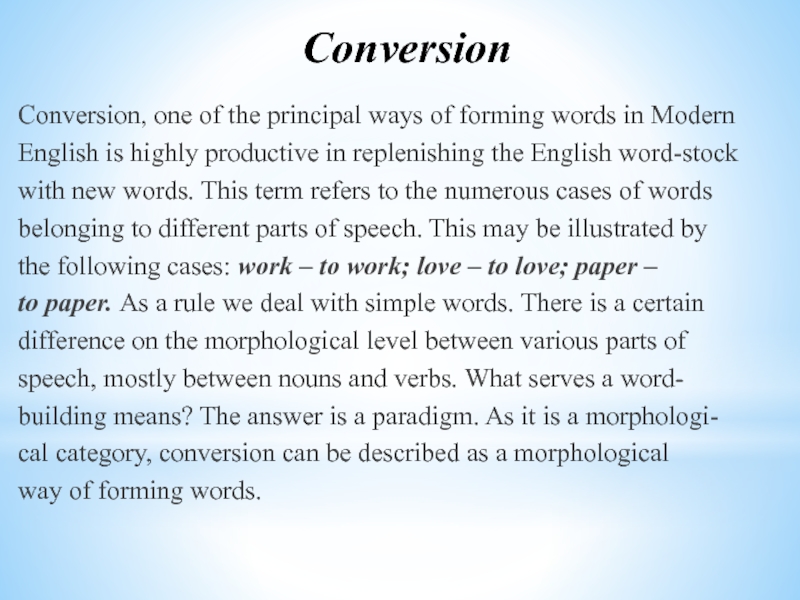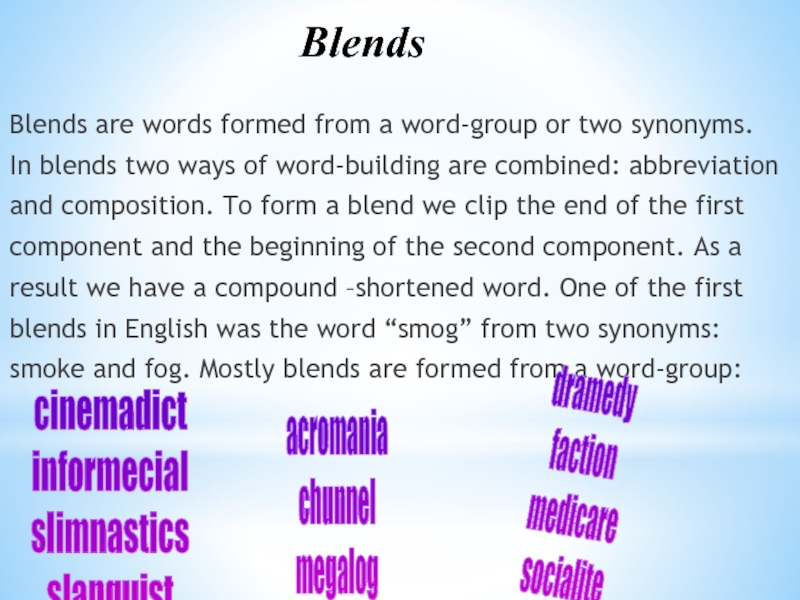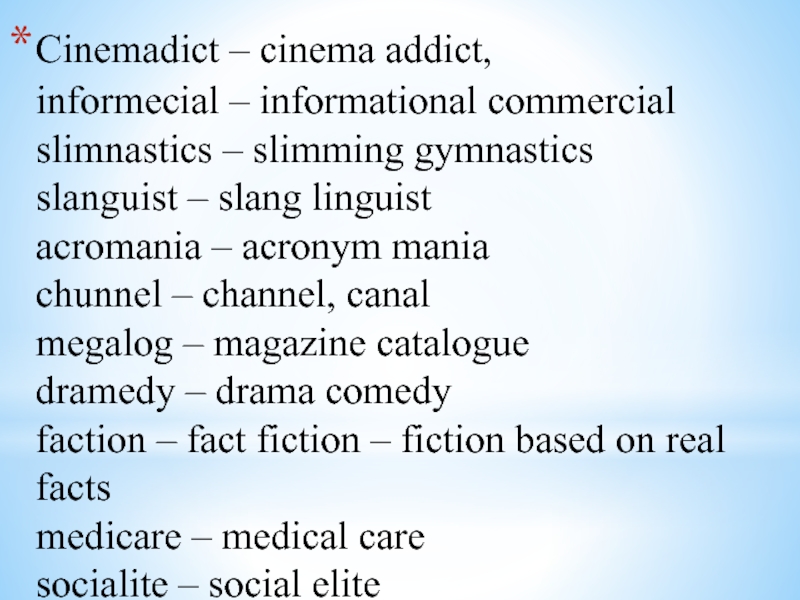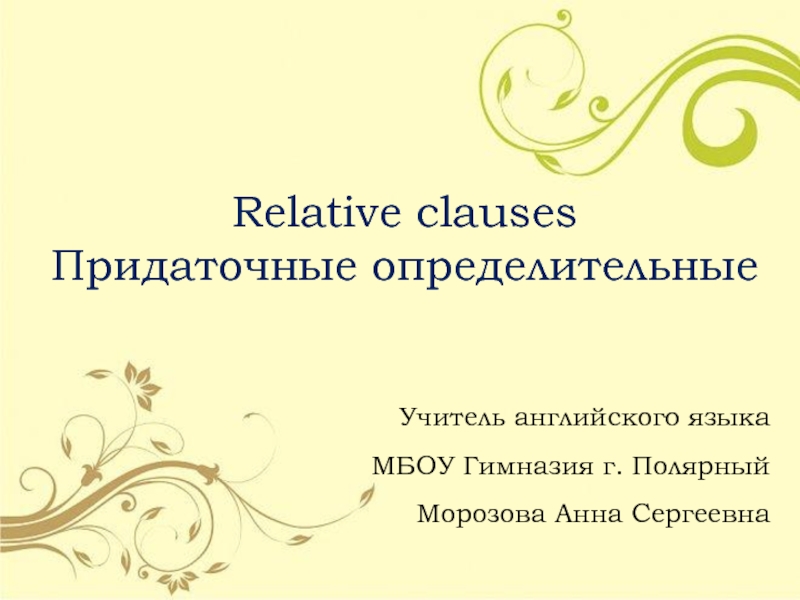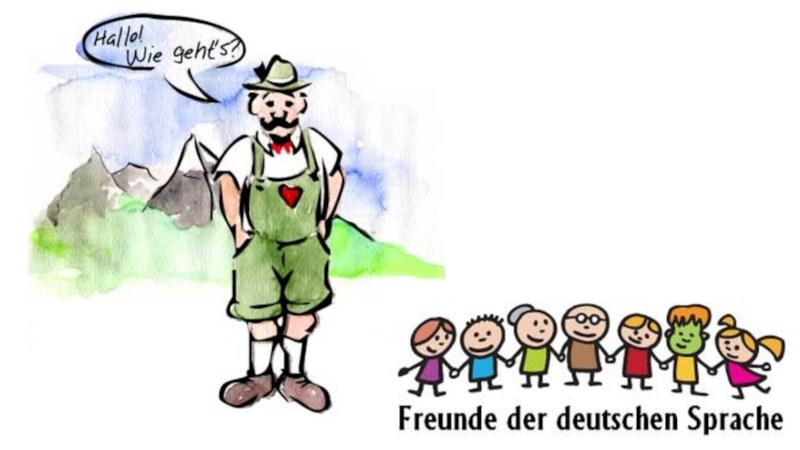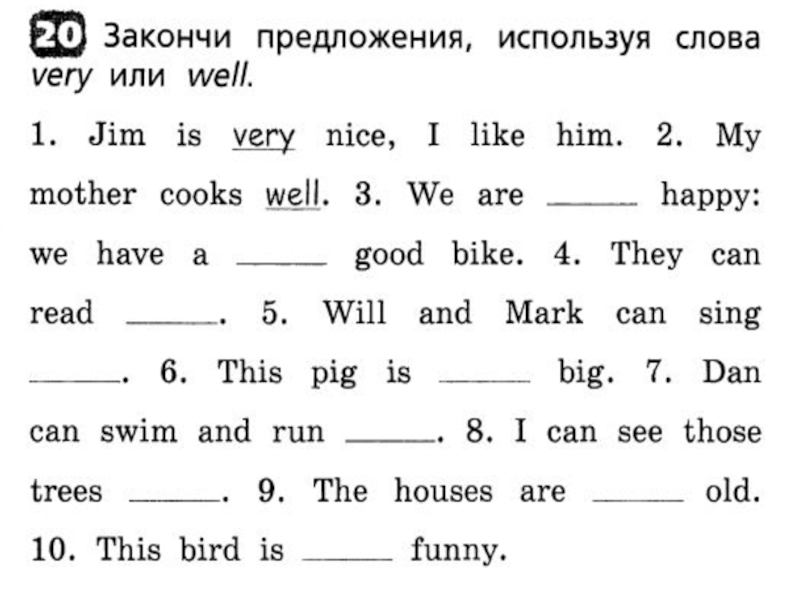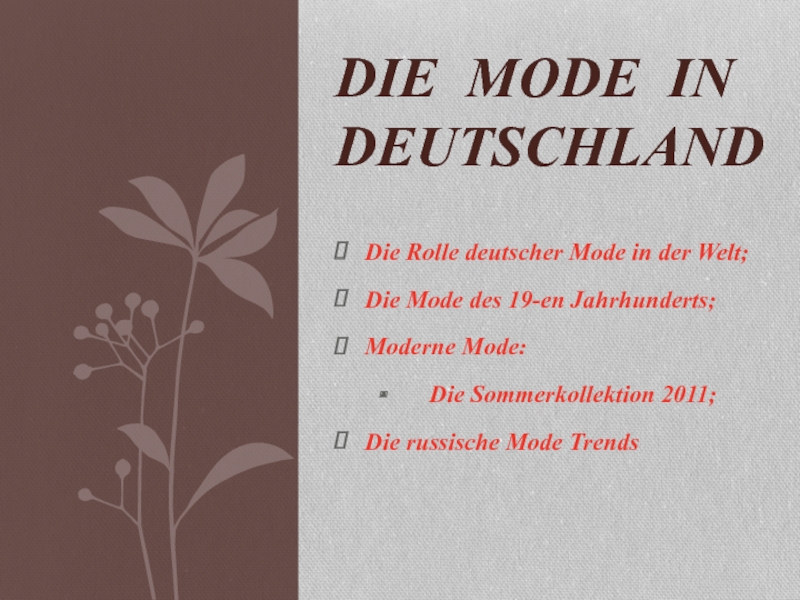Разделы презентаций
- Разное
- Английский язык
- Астрономия
- Алгебра
- Биология
- География
- Геометрия
- Детские презентации
- Информатика
- История
- Литература
- Математика
- Медицина
- Менеджмент
- Музыка
- МХК
- Немецкий язык
- ОБЖ
- Обществознание
- Окружающий мир
- Педагогика
- Русский язык
- Технология
- Физика
- Философия
- Химия
- Шаблоны, картинки для презентаций
- Экология
- Экономика
- Юриспруденция
Modern English Word Formation
Содержание
- 1. Modern English Word Formation
- 2. The aim of this work is to
- 3. It is a matter of common knowledge
- 4. The ways in which new words are
- 5. Unfathomable = negative prefix + adjective forming
- 6. An unabridged English dictionary contains about 600
- 7. Some words have many different meanings.Let’s take,
- 8. Context clues can help us learn the
- 9. Means of word-forming English is a living,
- 10. The words of the first kind, which
- 11. PREFIXES HAVE BROAD GENERAL MEANINGS LIKE ‘NOT’,
- 12. SuffixationIn Modern English, suffixation is mostly characteristic
- 13. There are two kinds of suffixes:
- 14. Derivational suffixes can be classified according to the parts of speech.Classification of suffixes
- 15. Noun suffixes
- 16. Adjective suffixes
- 17. Verb suffixes
- 18. Suffixes indicating smallness or lessening
- 19. When speaking about the structure of words
- 20. Compound nouns are nouns built from two
- 21. Stonewall combinationsIn Modern English there are lots
- 22. AbbreviationsThe causes of shortening can be linguistic
- 23. Such words as asleep, abed, ablaze,
- 24. Conversion, one of the principal ways of
- 25. Blends are words formed from a word-group
- 26. Cinemadict – cinema addict, informecial – informational
- 27. Скачать презентанцию
Слайды и текст этой презентации
Слайд 2The aim of this work is to teach students to
be word-conscious, to be able to guess the meaning of words
they come across from the meaning of morphemes, to be able to recognize the origin of this or that lexical unit.The task of the work is to show the ways of word building, i.e. affixation, suffixation, compounds, statives, vowel and consonant alternations and conversion.
Topical interest. This work is of topical interest because English is a living growing language. The system of its sounds is subjected to various changes, the words and word combinations undergo changes. The most noticible and most appreciable transformations occur in words that form part of English, that is in its vocabulary.
Слайд 3It is a matter of common knowledge that the vocabulary
of any language is never stable, but is constantly changing,
growing and decaying. The changes in the vocabulary of the language are due both to linguistic and extra-linguistic causes, which are determined by the social nature of the language. The intense development of science and technology has lately given birth to a great number of new words such as ‘computer’, ‘cyclotron’,’radar’, ‘psycholinguistics’, etc.; the conquest and research of outer space started by the Soviet people contributed words like ‘sputnik’, ‘lunokhod’,’babymoon’,’moon-car’,’spaceship’. It is significant that the suffix –nik occurring in the noun ‘sputnik’ is freely applied to new words of various kinds, e.g. ‘flopnik’,’mousenik’, ‘woofnik’,etc.Слайд 4The ways in which new words are formed, and the
factors which govern their acceptance into the language, are generally
taken very much for granted by the average speaker to understand a word, it is necessary to know how it is constructed, whether it is simple or complex, that is whether or not it can be broken down into two or more parts. We are able to use a word which is new to us when we find out what object or notion it denotes. Some words, of course, are more understandable than others.Слайд 5Unfathomable = negative prefix + adjective forming suffix = cannot be fathomed. Knowing
the pattern, we can easily guess the meaning of a
word although there are lots of other words which look similar, for instance, unfashionable and unfavourable for which this analysis will not work. We accept as quite natural the fact that although we can use the verbs ‘to pipe’, ‘to drum’ and ‘to trumpet’, we cannot use the verbs ‘to piano’ and ‘to violin’.Слайд 6An unabridged English dictionary contains about 600 000 words
The bad
news is that even if you have an
excellent vocabulary, you
know only a small percentage of those words. The good
news, however, is that you can increase
your vocabulary throughout your life. The
even better news is that once you have
learnt a new word, it is yours for life. It will
always be stored away, ready to be recalled
the next time you have a conversation or
write a letter or composition.
Слайд 7Some words have many different meanings.
Let’s take, for example, the
word ‘titanic’ in the following
sentences. 1. The Titanic sank
inthe North Atlantic on an April
night in 1912 after hitting an
iceberg. 2. The enemies were
locked in a titanic struggle. You
can tell from the first sentence
that Titanic is a ship and from the
second sentence that ‘titanic’
means “having great size, force
or power.
Слайд 8Context clues can help us learn the meaning of a
word. The context of a word is the sentence, the
surrounding words, or the situation in which the word appears. There are several types of them. 1. Definition or restatement is defined in the sentence ,e.g. We read a collection of fables, short stories that teach a lesson. 2. The meaning of the word is made clear by the example, e.g. Bombay is a populous city; one way the Indian government has tried to ease the overcrowding there is to build a second Bombay . 3. Comparison. e.g. Joseph has always been amiable – almost as friendly as his older brother Mark. ( As introduces a comparison between Joseph’s disposition and that of his older brother.) 4. Contrast. e.g. The mayor’s popularity, soared to its highest point, but the city council’s dropped to its nadir. ( A contrast is drawn between the highest point of the mayor’s popularity and the lowest point, the nadir, of the city council’s.Слайд 9Means of word-forming
English is a living, growing language; new
words are
constantly being added. English words come from many
sources.
Some come from the dead language Latin, andothers come from ancient Greek. Knowing the words and
parts of words borrowed from Latin and Greek can help us
understand the meaning of many English words. In general,
English words are of two kinds:
those that can be
analysed into smaller
parts:
untimely
those that cannot
time, face, feel
Слайд 10The words of the first kind, which can be divided,
are made up of parts called
prefixes
roots
suffixes
They offer clues
to
the meaning of the words.A root
is the part of a word
that carries the basic meaning.
A prefix
is one or more syllables
placed in front
of the root to modify the meaning of the root
or to form a new word.
Слайд 11PREFIXES HAVE BROAD GENERAL MEANINGS LIKE ‘NOT’, ‘UNDER’, ‘AGAINST’ AND ANY
OF THEM MAY APPEAR IN HUNDREDS OF DIFFERENT WORDS. BECAUSE PREFIXES OFTEN
HAVE MORE THAN ONE MEANING, THEY CAN BE HARD TO INTERPRET.The main function of prefixes
is to change
the lexical meaning of the same part of speech.
There are 51 prefixes in the system of Modern English word formation.
Prefixation
Слайд 12Suffixation
In Modern English, suffixation is mostly characteristic of noun and
adjective formation, while prefixation is mostly typical of verb formation. The
distinction also rests on the role different types of meaning play in the semantic structure of the suffix and the prefix. The part-of -speech meaning has a much greater significance in suffixes as compared to prefixes which possess it in a lesser degree. Due to it, a prefix may be confined to one part of speech as, for example, enslave, encage, unbutton ,or may function in more than one part of speech as over- in over kind, overfeed, overestimation.Unlike prefixes, suffixes as a rule function in any one part of speech often forming
a derived stem of a different part of speech as compared with that of the base, e.g. careless - care; suitable - suit, etc. Furthermore, it is necessary to point out that a suffix closely knit together with a base forms a fusion retaining less of its independence that a prefix which is as a general rule more independent semantically, e.g. reading- 'the act of one who reads'; 'ability to read'; and re-read — 'to read again'.
Слайд 13There are two kinds of suffixes:
Grammatical Derivational
-s, -ed, -ing
-ly,-ence,ize,-hood
grammatical provide a grammatical signal of some kind but don’t greatly
alter the basic meaning of the word and those that, by being added, create
new words. The endings
are suffixes
of the first kind. Grammatical suffixes are important in grammar, but in
vocabulary we are more concerned with the second kind of suffixes –
those that make new words – derivational suffixes.
Слайд 14 Derivational suffixes can be classified according to the parts
of speech.
Classification of suffixes
Слайд 19When speaking about the structure of words stems should
also
be mentioned. The stem is the part of the word
which
remains unchanged throughout the paradigmof the word. Stems have not only the lexical meaning but
also grammatical meaning. They can be noun stems, adjective
stems and verb stems. Sometimes it is rather difficult to
distinguish between simple and derived words, especially in
the cases of phonetic borrowings from other languages and
of native languages with blocked morphemes, e.g. “cranberry”,
“absence”,etc.
Roots
Слайд 20Compound nouns are nouns built from two or more roots.
They
often have one stress. The meaning of a compound
often differs
from the meaning of its elements. Compounding- is one of the productive types of word-formation in Modern English.
Compound words are inseparable vocabulary units.
They are formally and semantically dependent on the
constituent bases and the semantic relations between them
which mirror the relations between the motivating units.
The main types of compound nouns are as follows:
Compounds
noun-stem+noun -stem
apple-tree, snowball, newspaper
adjective stem+ noun stem
blackbird, whitehorn, blackleg
Слайд 21Stonewall combinations
In Modern English there are lots of word combinations
of the type price rise, wage freeze, steel helmet, sand
castle.Grammarians can’t come to the conclusion whether adjectives can be formed by means of conversion from nouns.
Слайд 22Abbreviations
The causes of shortening can be linguistic and extra-linguistic. Abbreviation
doesn’t change the part-of-speech meaning.
Examples: prof=professor, to rev=to revolve, comfy=comfortable.
Слайд 23 Such words as asleep, abed, ablaze, afraid, akin, alive
have
been named adjectives, though they can’t
be attributes in a sentence,
and though their meaningdoesn’t seem to be that of property. The a- means on,
in or at. Statives are invariable. They often show a
temporary state rather than a permanent one. They
most usually follow a link-verb (was asleep) or they
can be used like a participle, but they can’t go before
the noun they modify. In the sentence a stative is most
usually a predicative (he fell asleep).
The statives
Слайд 24Conversion, one of the principal ways of forming words in
Modern
English is highly productive in replenishing the English word-stock
with new
words. This term refers to the numerous cases of wordsbelonging to different parts of speech. This may be illustrated by
the following cases: work – to work; love – to love; paper –
to paper. As a rule we deal with simple words. There is a certain
difference on the morphological level between various parts of
speech, mostly between nouns and verbs. What serves a word-
building means? The answer is a paradigm. As it is a morphologi-
cal category, conversion can be described as a morphological
way of forming words.
Conversion
Слайд 25Blends are words formed from a word-group or two synonyms.
In
blends two ways of word-building are combined: abbreviation
and composition.
To form a blend we clip the end of the firstcomponent and the beginning of the second component. As a
result we have a compound –shortened word. One of the first
blends in English was the word “smog” from two synonyms:
smoke and fog. Mostly blends are formed from a word-group:
cinemadict
informecial
slimnastics
slanguist
dramedy
faction
medicare
socialite
acromania
chunnel
megalog
Blends


